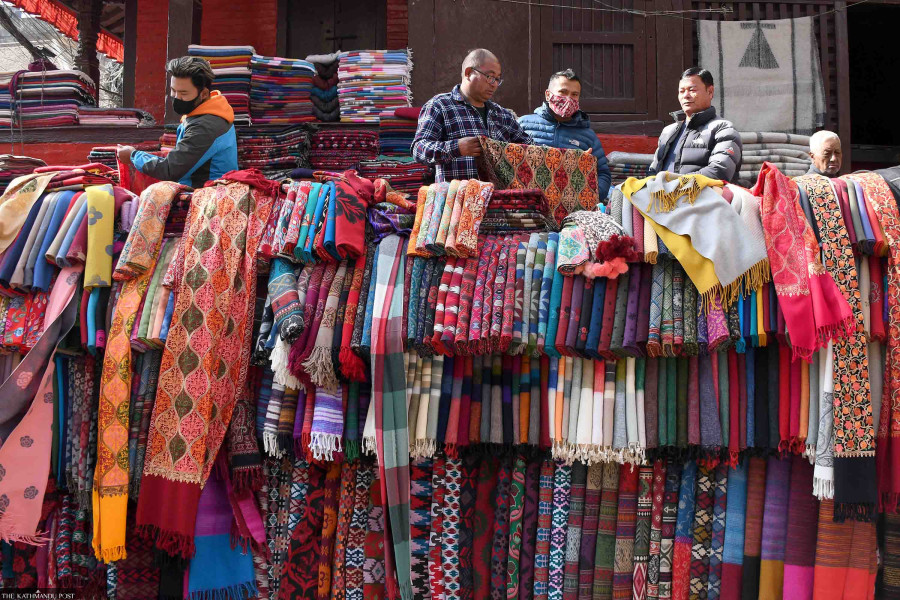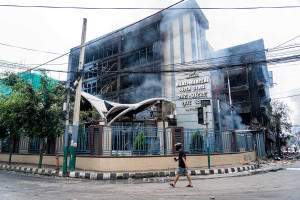Money
Merchants swat flies as customers stay home
According to economists, 50 to 60 percent of the year’s sales happen during the autumn festival season.
Subin Adhikari
Rakshya Bandhan, which marks the beginning of the festive season in Nepal, is two weeks away. But Sagar KC, proprietor of KC Brothers and Sons Fancy Store on New Road, doesn't see anything to be excited about. The annual buying rush isn't there.
Festivities and celebrations, apart form reinvigorating Nepalis spiritually, also set sales ablaze as holiday spenders throng the markets and snap up everything that shines.
Business booms, the government collects taxes, and everybody, from producers and suppliers to merchants and retailers, goes home happy. According to economists, 50 to 60 percent of the year's sales happen during the Dashain, Tihar and Chhath season.
KC, who imports apparels from China, says his phone would be ringing constantly at this time of the year during the good old pre-Covid days. He would be getting frantic calls from wholesalers in Kathmandu placing orders for clothes of new designs for the Teej and Dashain festivals.
This year, the phones are silent, and KC is swatting flies in his shop.
“Until 2019, I used to have daily sales of up to Rs50,000. But now, I hardly sell clothes worth Rs5,000 a day,” said KC. He says his business has plunged by 90 percent.
The trader claims that this is the toughest year he has faced in the past eight years, apart from the Covid lockdowns in 2020 and 2021. “Everything is now normal, but consumers are not showing up.”
Merchants on New Road, one of the country’s largest wholesale markets, are worried because of rising rentals, cost of goods and customs duties.
A women’s wear store next to KC is chockfull of designer kurtas and sarees, freshly imported from India for Teej. But the shop owner says there are no customers.
Traders say that high inflation and the exodus of youngsters—who are the major buyers of clothes during festivals—have dampened sales.
Nearly 1 million Nepalis are estimated to have left the country in the last fiscal year ended July 16.
Nepal plunged into its first recession in six decades during the first two quarters of the last fiscal year as economic output continued to be weighed down by inflation and political instability.
The National Statistics Office said the economy did not grow by more than 1.86 percent in the fiscal year 2022-23, the lowest growth rate since the fiscal year 2015-16 when Nepal was hit by earthquakes.
Economists say consumer confidence is still down in the first quarter of the new fiscal year as sentiment on both the current economy and expectations weakened.
Naresh Katwal, past president of the Nepal National Traders Federation, says a majority of importers are still undecided about importing goods because of low demand even though the festival season is approaching.
“Although there is enough liquidity in the banks, traders are hesitant to take loans. The interest rate on loans is still high,” said Katwal.
According to Nepal Rastra Bank, the year-on-year inflation in the first 11 months of the last fiscal year stood at 6.83 percent. Food and beverage inflation stood at 5.66 percent while non-food and service inflation rose to 7.76 percent in the review month.
Nepalis spend a high proportion of their earnings on consumption. According to the National Statistics Office, the final consumption expenditure or money spent by Nepalis on consumption, has been expected to reach Rs5.03 trillion in the last fiscal year, which is 93.59 percent of the total GDP.
But this year the markets are yet to come alive with high-spending shoppers. Economist Pushkar Bajracharya says the reason behind slow sales is high taxes. “It has stifled the economy,” he added.
The government has been blaming the Russia-Ukraine war for rising inflation. “But the reality is that taxes are so high that people are thinking twice before they go to the market,” said Bajracharya.
The government itself is broke. On Sunday, contractors held a protest by padlocking the offices of the director general of the Department of Roads and the Department of Water Resources and Irrigation. They are demanding that the government settle their unpaid bills which they say total Rs50 billion.
"The central bank tightened the monetary policy by increasing the interest rate in the last fiscal year to curb inflation. But the move decreased the people's purchasing power, and its consequences are now visible in the market," Bajracharya said.
The central bank has adopted several measures in the monetary policy for the ongoing fiscal year 2023-24 such as reviewing the capital-to-risk weighted assets ratio, working capital loan, and liberalising the provision of letters of credit for imports to rejuvenate the economy.
The monetary policy also aims to achieve 6 percent economic growth by keeping inflation below 6.7 percent in the current fiscal year.
But experts are sceptical.
“The targeted economic growth is unlikely to happen unless the interest rate is slashed further and the government increases its capital expenditure,” said Bajracharya.
“In the existing condition, neither the public nor the traders have enough money to spend. No spending means market activities will contract.”
Amid rising concern about subdued economic activities, Finance Minister Prakash Sharan Mahat said at an event on Tuesday that there was ample liquidity in the market. “The public has been panicking due to rumours that the economy is in crisis.”
But right after assuming office in April, Mahat himself had said that the economy was in crisis, and that he was ready to take any tough decision to improve it.
“Such rumours are making people afraid to spend and take loans. The private sector needs to be positive regarding the economy,” Mahat said on Tuesday.




 19.12°C Kathmandu
19.12°C Kathmandu













%20(1).jpg&w=300&height=200)
